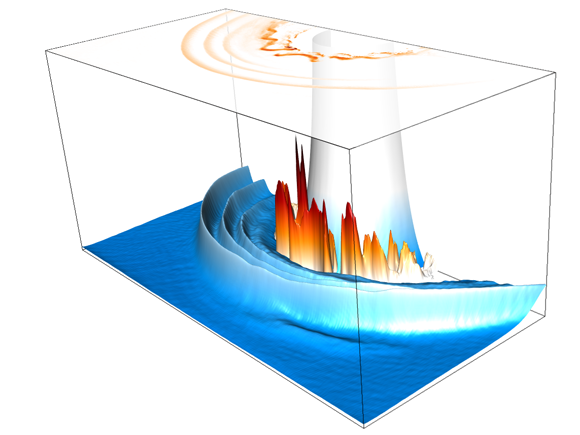Research Fields
The activities of GoLP are focused on research and advanced training in Plasma Physics, Advanced Photonics and Advanced Computing, through (i) research in frontier questions, grounded on a culture of entrepreneurship, creativity, and international collaboration, (ii) the outstanding quality of our members, and (iii) the commitment to the scientific and technological development of Portugal and Europe. The two teams at GoLP address a wide range of topics aligned with GoLP’s mission.
Extreme Plasma Physics Team
Under the action of extreme intensities, either due to lasers or particle beams, the collective behavior of plasmas, and the nonlinearities in plasmas, play a critical role and determine the dynamics of a wide variety of complex laboratory and astrophysical scenarios.

EPP team Image of the Year 2014
Generation of miniature magnetised shockwaves, F. Cruz
Relativistic kinetic theory provides the theoretical framework to describe these processes, and establishes a general description for the interaction of intense beams of charged particles, photons and neutrinos. However, the full nonlinear dynamics can only be explored with numerical simulations capable of capturing the kinetic features of plasmas and intense beam-plasma interactions.
In our team we address some of the problems associated with extreme intensities in plasmas, with a combination of plasma theory and massively parallel numerical simulations with a focus on the particle-in-cell algorithm and its extensions (e.g. hybrid codes), and resorting to some of the largest supercomputers in the World.
The research program at GoLP is focused on a few of the most challenging science questions in our field, as identified in several prospective surveys conducted by the National Academy of Sciences USA (e.g. Plasma 2010), DOE/NNSA (NIF Science 2012), and the EU (e.g. PRACE or the Exascale Software Intiative):
- How does matter behave in extreme electromagnetic fields, either at ultra-relativistic intensities, ultra-short timescales or at extremely hard wavelengths?
- Can one use plasma acceleration and other plasma-based techniques to develop compact accelerators for use at the energy frontier, in medicine, in probing materials, and in novel light sources for bioimaging?
- What are the mechanisms for particle acceleration in relativistic shocks and what can we learn about these cosmic accelerators in a laboratory experiment?
- Can advanced ignition concepts be used to develop inertial fusion energy?
- What are the enabling technologies to construct a laser with a peak power of over 1 Exawatt that would allow us to study matter subject to unprecedented forces?
- What are the conditions for the creation of pair plasmas in the laboratory under the action of ultra intense fields and what is the role of the self-consistent collective dynamics of such plasmas, in laboratory and in astrophysics?
- Can we tailor the properties of plasmas such that they exhibit exotic electromagnetic properties?
X-GoLP Team
Experimental work has shown along the years its importance regarding technology and knowledge in general. The discovery of the most coherent form of light, the laser, opened the window for new study fields, such as ultrafast optics or attosecond science, for example. Apart from their shorter duration comparing with conventional light, they allow to confine light energy in a small area, which is of tremendous importance when considering phenomena such as the interaction of light with matter.
The X-GoLP team is responsible for executing laboratory experiments in top laser-lab facilites. The focus is given to the investigation of laser techniques and optical instruments, in order to promote the development of improved devices, conceive alternative mechanisms for a more efficient study optical properties and also to confer support to the various branches of Science.

The following items include the main research fields of X-GoLP:
- High Intensity Lasers
- Coherent X-Ray sources
- High-Intensity Laser-Plasma interaction
- New radiation sources and optical physics








